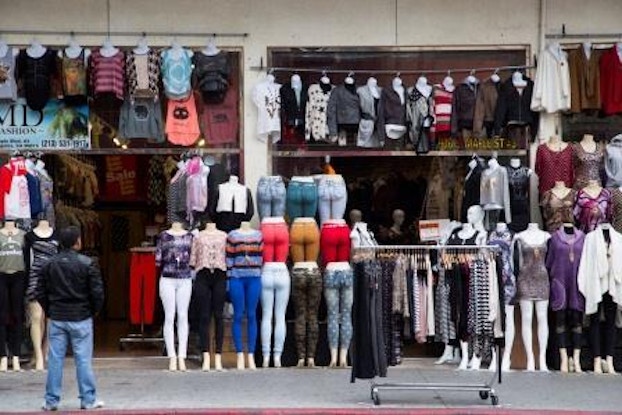
Bri Seeley sits in her small, shared space in the Los Angeles Fashion District, folding dozens of tops before attaching her namesake label to each piece.
Seeley, a native Minnesotan, brought her brand from Seattle to the City of Angels last year to indulge a passion for fashion that she couldn’t ignore.
“My grandmother taught me how to sew when I was about seven, so this has been something that’s just been in my blood,” said Seeley, in her studio off Los Angeles Street.
In LA, the designer has found the freedom to take an innovative approach to the fashion business — such as enabling online purchases of her entire collection while models were still walking the runway.

Interested in a small business membership?
Find out how the U.S. Chamber of Commerce can help your company grow and thrive in today's rapidly-evolving business environment. Connect with our team to learn how a small business membership can benefit your bottom line and help you achieve your goals.
“Being a fashion entrepreneur is a lot less about being a fashion designer than it is about being an entrepreneur,” said Seeley, who is currently managing her own customer service, web redesign, contract negotiation and a host of other activities that would have their own departments in large fashion houses.
While LA may lack the international profile and glam designers of New York or Paris, none of those new lines would make it to Saks or Neiman Marcus if it wasn't for the center of fashion commerce in this lesser-known corner of downtown.
Much like New York’s Diamond District or the Tokyo Fish Market, the LA Fashion District is where the industry gets down to business. When all the prototype dresses get unzipped and peeled off from the big fashion shows, designers phone in orders to their reps. Once filled with noisy factories, the hub now houses artists’ lofts for ambitious designers who manufacture their work in-house, as well as huge showrooms that hawk mainstream name brands.
“The fashion industry has always been a low capital-intensive industry,” said Kent Smith, executive director of LA Fashion District, an organized collective of property owners that pool their resources to help foster development in the local community. “It means that all you need is some great ideas and incredible work ethic and an entrepreneurial spirit to get going.”
Buyers converge from all over the world to check out new designers, see clothing lines, and even cash and carry boxes, crates or containers of ready-to-wear apparel. With more than 1,000 businesses in the district, it is the hottest destination for startup fashion and retail entrepreneurs who want to plug in to the $300 billion industry.
Given its close proximity to the port of Los Angeles, the District was shaped in large part by trade early in the 20th century. “The Fashion District is where all these goods are distributed throughout North America,” Smith said. “We call it the ‘creative center’ for all of the world of fashion. We have not only all the fashion designers represented, but all of the wholesale showrooms.”
In fact, many recognized brands as well as designers like Trina Turk and Tarina Tarantino got their beginnings there. Yet for many up-and-coming designers slogging away in a corner of the 110-block district, fame and fortune is still a while away.
This manufacturing center is home to more than just the dozens of factories who cut and sew work for the entire industry. Its inhabitants also include wholesale and part-time retail markets, the Flower Market, the Merchandise Mart, the world famous Santee Alley — a three-block outdoor market, a Camden-town-meets-Cairo-souk strip of garage-like retail spaces where cheap underwear fights for attention over handbags and cellphone cases.
Julio Serrano, a 28-year-old fashion entrepreneur who ventured from his native Mexico to get his own bite at the apple in the Fashion District, opened a retail costume jewelry enterprise, “High Bijoux,” along Santee Alley. “There’s a lot of people and a lot of cultures mixing here,” he said.
“I love to see people’s reaction when they come here,” said Ariana Gomez, marketing manager for LA Fashion District. “Because they expect the style of New York. It’s not like that here. Here, it’s about selling.”
And for designers like Bri Seeley, it’s also about the dream.
CO— aims to bring you inspiration from leading respected experts. However, before making any business decision, you should consult a professional who can advise you based on your individual situation.
CO—is committed to helping you start, run and grow your small business. Learn more about the benefits of small business membership in the U.S. Chamber of Commerce, here.







